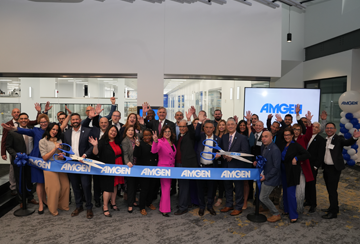Promoting quality care while managing healthcare spending is one of the greatest challenges facing the U.S. healthcare system—one further exacerbated by the COVID-19 pandemic, which has created significant financial burden for governments, hospitals and patients.
Of the myriad “cost-saving” proposals under consideration, most come with debatable benefits, unknown consequences, and threats to future treatment advances. One approach, however, has shown to effectively bend the cost curve while simultaneously protecting headroom for innovation: fostering competition supported by the introduction of reliably supplied, high-quality biosimilars.
Data from Amgen’s 2021 Biosimilar Trends Report demonstrate that competition supported by biosimilars has the potential to provide cost savings for public and commercial payers.1 Here’s a closer look at trends shaping the U.S. marketplace with biosimilars.
The U.S. marketplace for biosimilars is well-established, accelerating across multiple therapeutic areas
Since the first biosimilar launched in the U.S. marketplace in 2015, 30 biosimilars have been approved by the FDA and 21 biosimilars have been launched, giving patients and the healthcare system more treatment options and a greater degree of flexibility of choice.2 Biosimilars have gained substantial share in the majority of therapeutic areas where they have been introduced,3 with more payers adopting biosimilars, replacing originator products with biosimilars on their formularies, or designating biosimilars as preferred products.4,5
Biosimilars are contributing to healthcare system resiliency now...
Biosimilars are helping reduce healthcare costs by providing significant Wholesale Acquisition Cost and Average Sales Price savings at launch and through price competition.6 As time goes on, competition can lead to declining prices for both reference products and biosimilars, and we can expect to see increased savings for the healthcare system. As a result, the cumulative savings in drug spend for classes with biosimilar competition is estimated to have been $9.8 billion over the past five years in the United States.7
...and driving future cost savings and treatment options
This year’s Report features a new section on the future state of the marketplace, including how advancements in biosimilars can support the long-term sustainability of the U.S. healthcare system. So, what does the future have in store?
Biosimilar growth is expected to continue, with competition estimated to triple by 2023,8 as the U.S. marketplace sees biosimilars introduced for multiple therapeutic areas, including the potential approval of more interchangeable biosimilars. Anticipated entrants—including two Amgen biosimilar candidates—are expected to significantly impact the autoimmune class, the third largest therapeutic area by non-discounted drug spending. Over the next five years, it is estimated that biosimilars can save the U.S. healthcare system approximately $100 billion.9
Promoting a policy environment that facilitates continued success of biosimilars
Further, regulators and policymakers can continue to play an important role in driving understanding, reimbursement, acceptance, and adoption of biosimilars. As we look ahead, policymakers can best nurture a long-term, sustainable marketplace with biosimilars by maintaining effective policies that allow head-to-head competition among reference products and between biosimilars.
Download the latest Biosimilar Trends Report and watch Jen’s video below to learn more about how competition created by biosimilars is contributing to a more resilient healthcare system.
- IQVIA (2018). The Impact of Biosimilar Competition in Europe. PDF file. Retrieved from: https://www.medicinesforeurope.com/wp-content/uploads/2017/05/IMS-Biosimilar-2017_V9.pdf
- AmerisourceBergen. Biosimilar approval and launch status in US. https://www.xcenda.com/biosimilars-trends-report. Accessed September 2021.
- Data on file, Amgen; Biosimilars Market Share Trends; July 2021
- Miller S. Cigna continues efforts to lower prescription drug costs by promoting biosimilars. Cigna website. https://www.cigna.com/about-us/newsroom/innovation/cigna-continuesefforts-to-lower-prescription-drug-cost. Published June 2021. Accessed July 19, 2021.
- UnitedHealthcare. Medical benefit specialty drug update bulletin. https://www.uhcprovider.com/content/dam/provider/docs/public/resources/news/2020/sdub/medbenefit-specialty-drug-update-bulletin-october-2020.pdf. Published October 2020. Accessed July 19, 2021.
- Data on file, Amgen; Product and Biosimilars - WAC and ASP Price; July 2021
- Data on file, Amgen; Biosimilars Spend Analysis; July 2021
- IQVIA Institute for Human Data Science. The Global Use of Medicine in 2019 and Outlook to 2023. January 29, 2019. URL: https://www.iqvia.com/institute/reports/the-global-use-of-medicine-in-2019-and-outlook-to-2023. Accessed September 2021.
- IQVIA. A positive road ahead for biosimilars?. January 2021. https://www.iqvia.com/insights/the-iqvia-institute/reports/a-positive-road-ahead-for-biosimilars.





